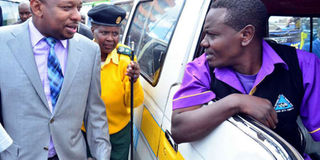Action on jam to make or break Sonko

Nairobi Governor Mike Sonko chats with a matatu driver on September 20, 2017 at Hakati Terminus. Being Governor of Nairobi is Sonko’s hour of reckoning. PHOTO | FRANCIS NDERITU | NATION MEDIA GROUP
What you need to know:
- According to the 2012 IBM Commuter Pain Index, Nairobi residents have the fourth-most painful commute in the world.
- Urban transport cannot be left in the hands of private sector operators who can hold an entire city to ransom by withdrawing services.
Governor Mike Mbuvi Sonko is first among equals. Nairobi County is the largest in terms of population, houses the capital city, receives the largest allocation of devolved funds and is an economic hub that generates the highest revenue to the Exchequer.
In this regard, the economic, social and political development of Kenya, as envisaged in the Vision 2030 blueprint, is closely linked to that of Nairobi.
It thus follows that Sonko’s success or failure will affect the entire country.
CHALLENGES
That’s why being Governor of Nairobi, County 047, is Sonko’s hour of reckoning.
His decisions and actions will either make or break him.
It’s his opportunity for take-off into national leadership or his watershed to political obscurity.
Nairobi has many challenges that threaten its success, a major one being traffic congestion.
The traffic is simply impossible, unbearable and untenable.
TRAFFIC JAM
According to the 2012 IBM Commuter Pain Index, Nairobi residents have the fourth-most painful commute in the world.
As the roads are clutched in a gridlock, no one is exempt; workers, business people and students are stuck in what has been described as “the largest parking lot south of the Sahara and north of the Limpopo”.
Commuters take two to five times as much time to get to their destination as on clear roads.
The economy loses Sh50 million daily in fuel consumption, loss of man-hours and cancelled business appointments.
ENVIRONMENT
The traffic-related fuel, rubber and tar pollution and stress are health hazards.
Traffic jams provide a field day for carjackers, muggers, pickpockets and other opportunistic criminals.
Altogether, these consequences of traffic congestion cost Kenya Sh37 billion annually.
Sadly, Sonko’s first attempt at ridding the city of traffic jams fell flat on the face.
He postponed implementation of his gazette notice banning public service vehicles from the CBD for a month to give “matatu owners time to regulate themselves”.
PLANNING
In simple language, he could not withstand pressure from the matatu sector!
But that was predictable and inevitable for Sonko is governor courtesy of a political system where matatu owners, crew, touts and passengers are voters.
Sonko did not take into consideration the 29th Law of Power as described by Robert Greene.
He did not “plan all the way to the end”, taking into consideration the process and consequences, obstacles and twists likely to stand on the way of his decongestion plan.
RESEARCH
But he would have benefited from the many studies on traffic decongestion in the city over the past 40 years — the first being the Nairobi Metropolitan Growth Strategy of 1973 and the most recent the Transport and Urban Decongestion Committee (TUDC) of 2014.
The TUDC comprised stakeholders from the public and private transport sectors, engineering, business, legal, banking and resident associations.
Their systematic review of previous studies, a questionnaire-based survey of 2,489 respondents stratified from all Nairobi’s 17 sub-counties, focus group discussions and in-depth interviews among key stakeholders generated quantitative and qualitative data, from which conclusions were drawn and recommendations given.
PASSENGERS
The TUDC report presented to Governor Evans Kidero in May 2014 documented factors contributing to traffic congestion.
Among them were an informal, uncoordinated and privately owned public low-capacity transport system and a lack of efficient and reliable State-owned mass transport system (MTS).
Considering the first factor, Sonko was right: Trips of low-capacity PSVs from the five corridors into the city must terminate at designated peripheral points.
What he however did not take into account is the consequences of the terminated journeys to passengers destined for the CBD and beyond.
EXPERTS
TUDC recommended an alternative efficient, reliable, safe and affordable high-capacity MTS — be it bus, tram, light rail or metro — operating at a nominal fare, criss-crossing the CBD.
Other cities have dealt with this matter.
Urban transport cannot be left in the hands of private sector operators who can hold an entire city to ransom by withdrawing services.
This is what happened to Sonko and will continue until he considers tried and tested solutions, like a public MTS.
Since decongestion and politics are intertwined, my prediction is that he will either win both or lose both.
Prof Mutugi is the deputy vice-chancellor, University of Kabianga. She was the chairperson of the defunct Nairobi Transport and Urban Decongestion Committee (TUDC). [email protected].





